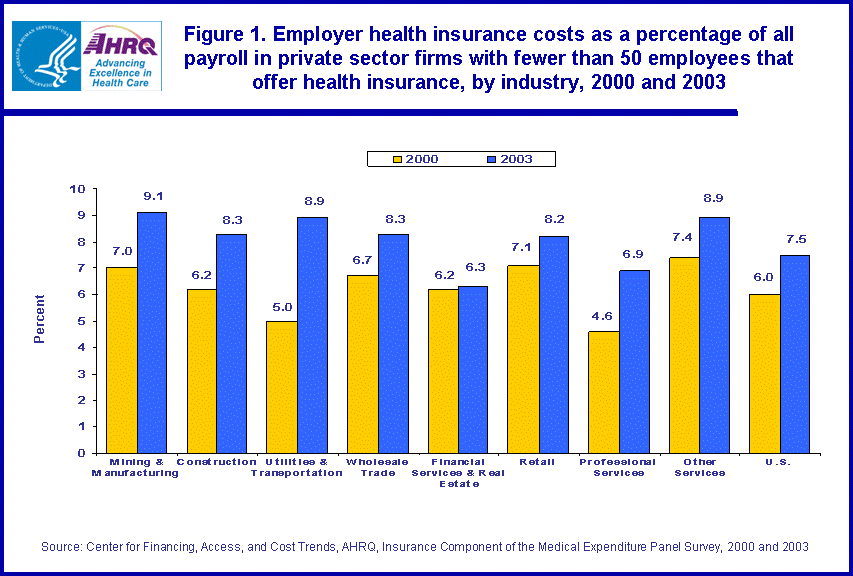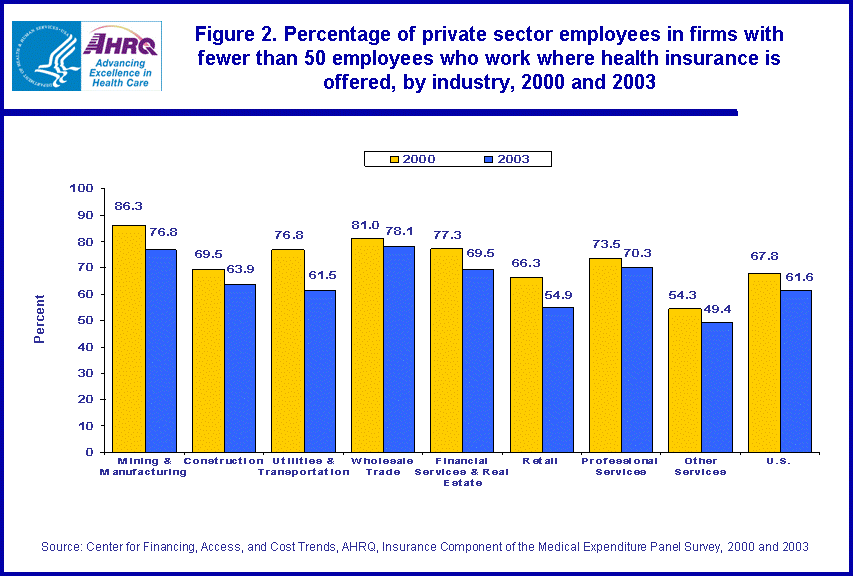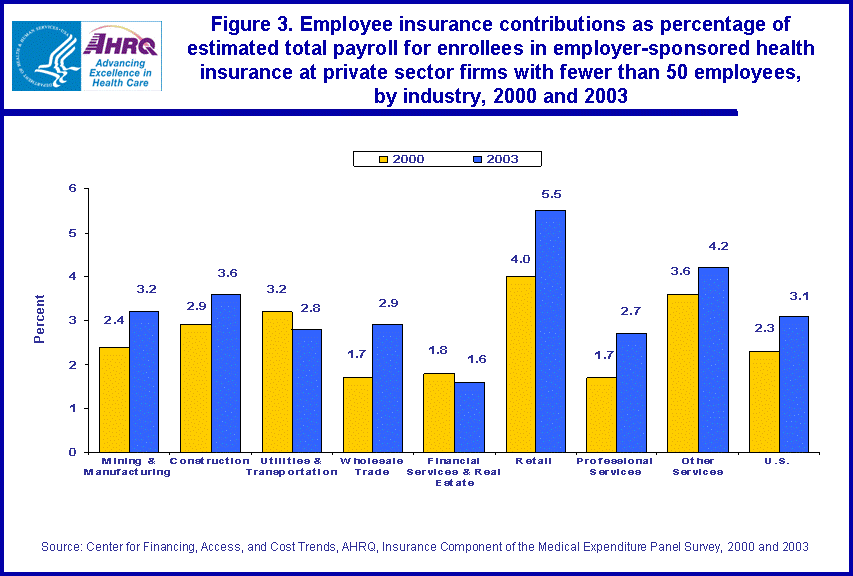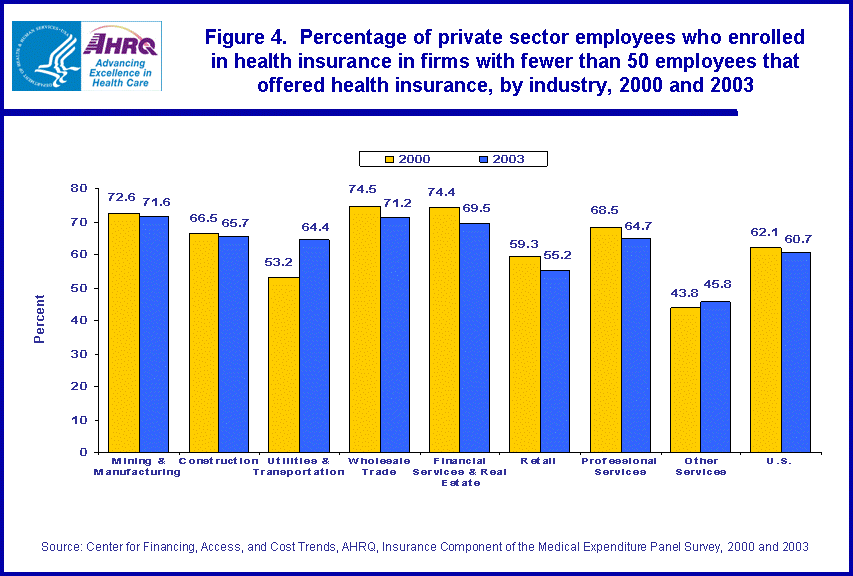
|
|
Font Size:
|
||||
|
|
|
|
||||
STATISTICAL BRIEF #98:
Employer-Sponsored Health Insurance Costs, Offer Rates, and Take-Up Rates for Small Employers in the Private Sector, by Industry Classification, 2000 and 2003
Highlights
- Costs to small private sector employers who offered employer-sponsored health insurance to their employees as a percentage of their total payroll costs rose from 6.0 percent in 2000 to 7.5 percent in 2003, with substantial variations by industry classification.
- Between 2000 and 2003, the percentage of employees who worked for small private sector employers who offered health insurance dropped from 67.8 percent to 61.6 percent, with variations by industry classification.
- The total employee contributions per payroll of enrolled employees at small private sector employers who offered health insurance rose from 2.3 percent in 2000 to 3.1 percent in 2003, with variations by industry classification.
- The percentage of employees of small private sector firms who worked where health insurance was offered and enrolled in employer-sponsored health insurance did not change significantly between 2000 and 2003.
Introduction
In 2000, according to the Insurance Component of the Medical Expenditure Panel Survey (MEPS-IC), the cost for employer-sponsored health insurance for 64.3 million active enrollees in the private sector in the United States was $295 billion. This was approximately $4,591 per active enrollee with any type of coverage: single, family, or one-plus-one. This cost was shared by employers who offered health insurance and the active enrollees. In 2003, the same cost for 60.7 million active enrollees in the private sector was $6,095 per active enrollee, a total of $370 billion. The costs per enrollee had increased 32 percent. This rate was much higher than the approximately 7 percent increase in the Consumer Price Index for All Urban Consumers for the same time period.1
Increases in the cost of health insurance are a large concern for small private sector employers (those with fewer than 50 employees). According to the 2002 National Survey of Small Businesses,2 67 percent of the executives surveyed were dissatisfied with the costs of employer-sponsored health care and felt that rising costs would lead to disruptions in coverage.
This Statistical Brief examines health insurance costs for small private sector employers and their enrolled employees as a percentage of payroll, by industry, for the years 2000 and 2003. The brief also shows the percentage of employees who worked at small private sector employers where health insurance was offered in those years and the percentage of these employees who enrolled during those years. These offer and participation rates for small private sector employers are a possible indication of employer and employee reactions to the large changes in costs between 2000 and 2003.
All differences between estimates discussed in the text are statistically significant at the 0.05 level unless otherwise noted.
Findings
Small private sector employers who offered health insurance spent an average of 6 cents per dollar of payroll on employee health insurance costs in 2000 (figure 1). By 2003, this cost rose to 7.5 cents per dollar of payroll for small employers who offered health insurance, a 25 percent increase. The largest real gain in costs was in the Utilities and Transportation industry, whose costs rose from 5.0 to 8.9 cents per dollar of payroll, an amount higher than the national rate. During the same time period, the Financial Services and Real Estate industry showed a smaller than average increase.
Between 2000 and 2003, the percentage of employees in small firms who worked where health insurance was offered dropped from 67.8 percent to 61.6 percent (figure 2). During that time frame, the offer rate for small businesses in most industries showed a significant decline. The Utilities and Transportation industry showed a decline that was higher than average. Only Wholesale Trade and Professional Services did not show significant declines in offer rates by small businesses.
Between 2000 and 2003, the total contribution by enrolled employees at small private sector firms rose from 2.3 to 3.1 percent of the total average payroll for enrolled employees (figure 3). This percentage of payroll rose in all industries except Utilities and Transportation and Financial Services and Real Estate, where there was no significant change.
The percentage of employees who worked for small private sector employers who offered health insurance and enrolled in their employer's plan changed from 62.1 to 60.7 percent, respectively, between 2000 and 2003 (figure 4). This reduction was not statistically significant.
Data Source
This Statistical Brief summarizes data from the 2001 and 2003 MEPS-IC. The data are available on the MEPS Web site (http://www.meps.ahrq.gov) or have been produced using special computation runs on the confidential MEPS-IC data available at the U.S. Census Bureau.
Definitions
In this Statistical Brief, an employer is defined as a private sector firm. A firm is defined as a business entity that controls one or more business establishments or locations. Consequently, an employer can have multiple work locations. Only small employers with fewer than 50 employees across all their locations were included in this analysis.
The classification by industry is based upon the North American Industrial Classification System.
All payroll and contributions were annualized for this paper.
Payroll includes all forms of compensation, such as salaries, wages, commissions, dismissal pay, bonuses, and employee contributions to pension plans. Payroll excludes fringe benefits. This definition is the same as that used by the Internal Revenue Service on Form 941.
Total payroll at firms that offer health insurance was estimated using the weighted sum of total annual payroll for establishments (locations) in the sample.
Total payroll per enrolled employee was obtained by using average payroll per employee reported for each establishment in the sample that offered health insurance. This value was multiplied by the number of enrolled employees at the establishment. The weighted sum of these values was taken as an estimate of the total payroll for enrolled employees.
Total contributions for enrollees by employers where health insurance is offered was estimated by taking the employer portion of each type of plan (single, one-plus-one, and family) and its associated premiums at the sample establishment and multiplying by the associated plan enrollments. These values were summed over all plans and types of enrollment at the establishment, and the weighted sum of these values across all establishments was used as the estimate of total employer contributions.
Total employee contributions were calculated with a method parallel to that used for employer contributions.
About MEPS-IC
MEPS-IC is a survey of business establishments and governments that collects information on employer-sponsored health insurance, such as whether insurance is offered, enrollments, types of plans, and premiums. The survey is conducted annually by the U.S. Bureau of the Census under the sponsorship of the Agency for Healthcare Research and Quality. The yearly response rate has averaged 78 percent for in-scope sample units. Approximately 4 percent of the original sample has been out-of-scope in a typical year. A total sample of 42,000 establishments was selected for the 2003 survey, prior to accounting for losses due to nonresponse and out-of-scope cases.
For more information on this survey, see MEPS Methodology Reports 6, 8, and 10 under MEPS publications at http://www.meps.ahrq.gov/mepsweb/data_stats/publications.jsp and the MEPS-IC Technical Appendix at http://www.meps.ahrq.gov/mepsweb/survey_comp/ic_technical_notes.shtml.
Suggested Citation
Sommers, J. (AHRQ) and Keach, R. (Census Bureau). Employer-Sponsored Health Insurance Costs, Offer Rates, and Take-Up Rates for Small Employers in the Private Sector, by Industry Classification, 2000 and 2003. Statistical Brief #98. September 2005. Agency for Healthcare Research and Quality, Rockville, Md. http://meps.ahrq.gov/mepsweb/data_files/publications/st98/stat98.shtml
AHRQ welcomes questions and comments from readers of this publication who are interested in obtaining more information about access, cost, use, financing, and quality of health care in the United States. We also invite you to tell us how you are using this Statistical Brief and other MEPS data and tools and to share suggestions on how MEPS products might be enhanced to further meet your needs. Please e-mail us at mepspd@ahrq.gov or send a letter to the address below:
Steven B. Cohen, PhD
Director
Center for Financing, Access, and Cost Trends
Agency for Healthcare Research and Quality
540 Gaither Road
Rockville, MD 20850
Footnotes
1Bureau of Labor Statistics Web site: http://www.bls.gov/data/
2 Kaiser Family Foundation. National Survey of Small Businesses. April 2002. Menlo Park, CA, Publication Number 200204022.
 |
||||||||||||||||||||||||||||||||||||||||||||||||||
|
||||||||||||||||||||||||||||||||||||||||||||||||||
|
|
||||||||||||||||||||||||||||||||||||||||||||||||||
 |
||||||||||||||||||||||||||||||||||||||||||||||||||
|
||||||||||||||||||||||||||||||||||||||||||||||||||
|
|
||||||||||||||||||||||||||||||||||||||||||||||||||
 |
||||||||||||||||||||||||||||||||||||||||||||||||||
|
||||||||||||||||||||||||||||||||||||||||||||||||||
|
|
||||||||||||||||||||||||||||||||||||||||||||||||||
 |
||||||||||||||||||||||||||||||||||||||||||||||||||
|
||||||||||||||||||||||||||||||||||||||||||||||||||
|
|
||||||||||||||||||||||||||||||||||||||||||||||||||


